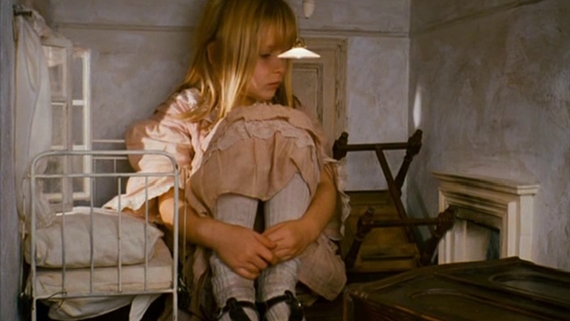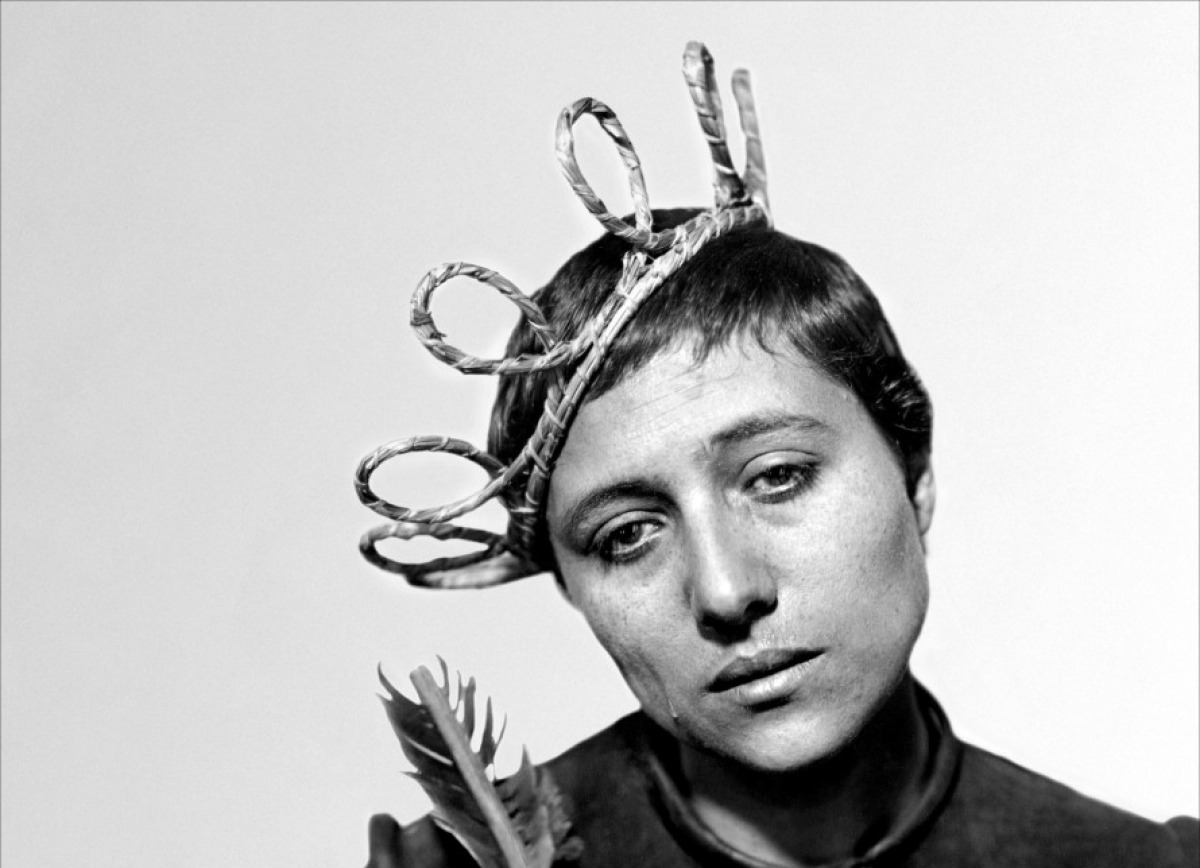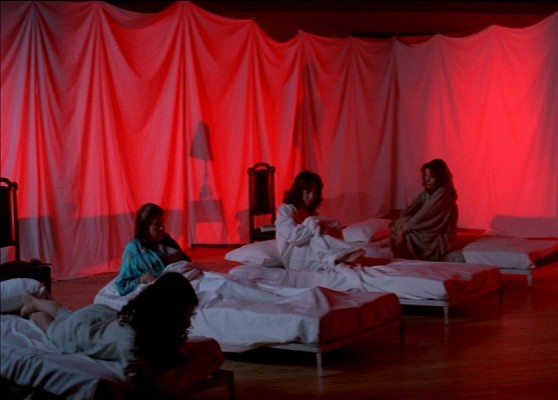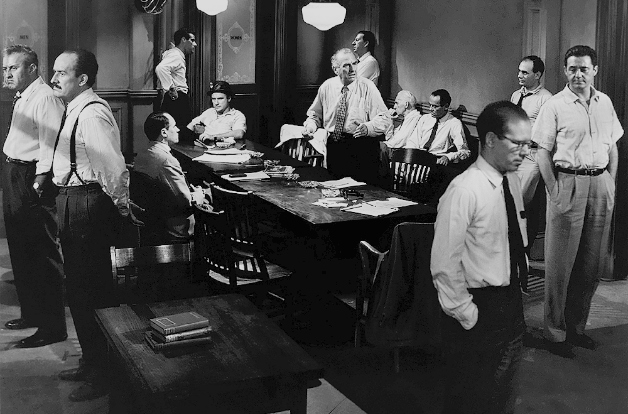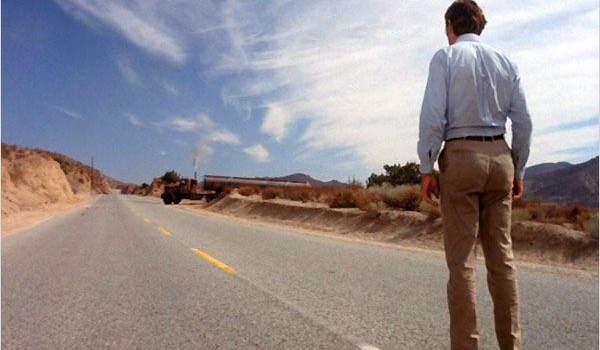5. Alice (Jan Svankmajer, 1988)
Even the literary layman is familiar with Lewis Carroll’s Alice’s Adventures in Wonderland. Even those who have not read it are familiar of the novel’s ubiquitous universe, of its psychedelic, transformative and absurd world of white rabbits with pocket watches and hookah-smoking caterpillars.
Jan Svankmajer wallows in the absurd. His films are peculiar little things that he conjures up through the otherwordly jerky movement of stop motion. Svankmajer probably recognized the strange elusiveness of the novel as its crux so he narrowed his film down to a surreal collection of textures, weird movement and hyper sounds. The universe of the novel is translated into an oneiric stream-of-consciousness tale that takes Alice’s most interesting element, that of spatial and temporal disorientation, and amplifies it.
The film substitutes most of the dialogue in the novel with a surreal magnification of sounds, of footsteps, ticking clocks, creaking and crackling of wood and rusty metal and images of grotesque transformation. We see Alice in her room, cluttered with objects like rotten apples, butterflies in glass casing, fossils and geisha-faced dolls. We hear an antique clock ticking.
Then we see Alice throwing stones into a cup of tea. When she stares at a white bulb above her head, we hear electrical noise. Her attention is drawn next to a model rabbit escaping its glassy confinement. It dresses in old-fashioned clothes and breaks the glass with a pair of long scissors. The scenes are enhanced by sounds that seem an exaggeration of the actual sounds, that of creaking wood and clicking of the rabbit’s feet as it walks out of its glassy cell.
The film is clever at revealing time and space as illusory and ever-changing. One second, Alice is in her room, the next she is transported to a sandy wasteland. A drawer appears into which Alice is swallowed. Again, she finds herself in a different place, that of a moldy cavern alluding to that of Carroll’s rabbit hole. The interchanges are cleverly interwoven, robbing space of any solidity.
The minimal treatment of the novel by focusing on a specific mood, enhanced by a world of rusty nails, sawdust lunches, and tears that can drown a room prioritizes emotion over the cerebral. Alice at times looks like she has been swallowed by a carpentry workshop that has gone haywire. Svankmajer departs even further from the novel by not giving the audience any key to decipher this child nightmare. His main concern seems to simply drag us off into this menacing labyrinth of magnified texture and sound.
4. The Passion of Joan of Arc (Carl Theodor Dreyer, 1928)
Carl Theodor Dreyer’s visual translation of the account of Joan of Arc’s trial and execution is an utterly minimal one. Dreyer here minimizes the historical in his retelling and stresses on capturing the gut-churning suffering of his unfortunate maid possessing heavenly visions.
The story goes: A country maid leads the French troops against the British occupation and is eventually captured. She is brought before judges of a church court and accused of heresy for revealing that her beliefs had been the cause of celestial visions. She would be tortured and later crucified at the stake.
Dreyer’s film dispenses with spatial continuity or costume-drama extravaganza in favour of a succession of close-ups. The striking element is Maria Falconetti (though her only film) as Jeanne D’arc, who embodies the fear and suffering weighing down on the sacrificial maid as she is accused and humiliated before a sea of angry faces.
Dreyer aims his camera constantly at faces, juxtaposing Joan of Arc’s sad, tear-drenched withering face with that of the stubborn and unsympathetic faces of her accusers. Though Dreyer, in opposition to Bresson’s rigorous discipline, makes use of Falconetti’s theatrical background and emotional displays. But he restricts the film to close-ups and medium shots of the faces, and so brings us into contact with the fundamental element of this historical account: despair.
3. Suspiria (Dario Argento, 1977)
The much imitated but never rivaled Dario Argento takes influence from the macabre tales of Edgar Allen Poe and constructs colourful and rich nightmares. Generic horror may have a bad rep over the years for its over involvement in sensation and indulging the body in quick jerky reactions and though Argento dabbles in cheap scares every now and then, his films relate very much to a genuine feeling of dread.
Suspiria uses a version of a simple and outdated narrative. An American girl arrives at a ballet academy in Munich that turns out to be a front for a witch coven who sadistically murders the young aspiring ballet students. Not much else happens in terms of plot. As with Glazer in Under The Skin, Argento’s interest lies in blazing a visual trail of terror and fear instead of relying on plot particulars. Nothing does or is supposed to make sense in the film.
Argento takes time to compose his shots and decorate his ballet school. The school is enameled in red velvet and haunted by rich Gothic interiors. His geometric compositions indulge in the school’s complex architecture and he lights scenes with overwhelming reds, greens and blues. The killings are disturbingly gruesome not because of their violent nature but because they are instantly attractive to the eye.
The first killing in the film is a labyrinth of the unnatural. It ends with a girl being stabbed and hung by the neck in a spacious room, breaking the ceiling glass, suspended like an icon surrounded by complimenting architectural shapes. Spilled blood takes on a velvety rouge colour. The camera slowly trails down from the girl’s suspended bloodied feet to her friend lying on the floor, shards of glass in her body and face. The pools of blood, coloured glass shards and checkerboard floor all form one big gory mural.
Argento is a painter painting with fat bloody strokes, nonchalant about the painting’s content, rather the atmosphere of it and how it instantly creeps into the unconscious. He is reminiscent of Bosch and his colourful landscapes of the grotesque. This is what gives Argento the edge over many other horror film makers looking to inspire physiological reactions.
2. 12 Angry Men (Sidney Lumet, 1957)
Maybe the most dramatic and prolix film on this list, 12 Angry Men is still daring in its spatial condensation. The film, except for the opening and epilogue, takes place in a jury room and occasionally in the next door bathroom. 12 men with utterly different qualities argue over the innocence of a boy who is convicted of stabbing his father.
The clues point towards the boy’s guilt, so most of the men pronounce him guilty. One, played by the lanky but tenacious Henry Fonda, has a different point of view. He doesn’t say the boy is innocent but that he could be. They argue for the remainder of the film, some more aggressively than others. They keep mulling and digging through clues until eventually, all members decide on the boy’s innocence. But the truth of the crime is never revealed.
Our experience is centered on the confrontation between the men. The crime is what Hitchcock called a “McGuffin”, a device that acts as a trigger for the plot but in itself is unimportant and interchangeable. Though here, the McGuffin serves no plot. More importantly, the crime reveals more and more about the 12 personalities, their behavior is observed and their weaknesses gradually pronounced when reacting to different aspects of the case.
The film substitutes spatial variety with a myriad of personalities. A calmly calculating stockbrocker. A wise-cracking salesman. A stubborn senior citizen. A vacant advertising man who, maybe thinking he is in a business meeting, swaying back and forth in his decision depending on what the majority agree with. And others with their own quirks and shortcomings that imbue the film with vivacity.
The room gradually intensifies as the arguments become more heated and the hostility unfurls. Lumet heightens the bad blood among the men by gradually changing the focal length of his camera lenses so that the room would look smaller and smaller, as if closing in on the characters. Limiting a film and restricting its spatial barriers has always been a great visual tool for exploring a mind in doubt, disorientation or inescapability.
Roman Polanski did the same in Repulsion, manacling Carol to her flat to draw her delusions of rape as well as The Tenant to show a fractured mind. So did Alfred Hitchcock with his film Rope, where his characters are caught at a moral impasse after murdering their colleague. It all unfolds in a single setting. Through Lumet’s camera, we moderately come to know his 12 characters, their behavior, and peculiar habits.
1. Duel (Steven Spielberg, 1971)
Spielberg’s first feature films deals intimately with paranoia through an elementary and uncompromised storyline. A traveling salesman is being chased down the highway by a sadistic fuel tanker who wants to play mind games. The film inhabits the unfortunate man’s mindset on his psychological journey to find reason for the truck driver’s erratic assaults.
For a film by the man who directed Saving Private Ryan and AI, Spielberg seems at his most potent in this simple quick narrative of thoroughfare molestation. Maybe having more money and more means can make a film maker forget about the intricacies of the modest. Only very little information is given of the protagonist and near to none is given of his assailant. The film then places us in a position of instability like that of the paranoid truck driver’s victim.
Once again, the protagonist is taught no moralizing lessons about his or the life of others. Our initial thoughts of what one might call a plot lead us to believe that once we know who this sadist-on-the-street is, then we get a clearer picture of the unfortunate protagonist himself. That notion is crushed under two tons of steel, as we get no answers to the why or even the who. Duel is not about the whos or whys. It is about raw experience.
The salesman later stops next to a stranded and overheated bus full of children. He acts unhinged when the truck is spotted again. He rushes away in his car and turns around to spot the fuel tanker stop behind the bus. The truck driver helps push the bus back on track. The salesman grows more confused with the erratically moral performance of his assailant. The film tells us it is strictly about paranoia and how we tend to exaggerate our own fears as much as the imagination allows.
Author Bio: Hassan Husseini is a film fanatic from Lebanon and currently resides in Newcastle upon Tyne, England. He has a BA in Graphic Design and has just finished a BA in Film Studies from Northumbria University. His research includes European Cinema, Sex and Transgression in the films of Pier Paolo Pasolini, Serial Killers in film, and the representation of death in cinema and television.
